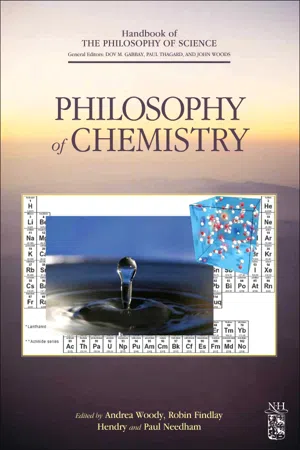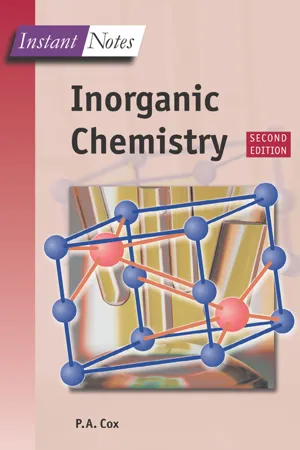Chemistry
Resonance Chemistry
Resonance in chemistry refers to the concept where multiple Lewis structures can be drawn for a molecule, and the actual structure is a hybrid of these resonance forms. It helps explain the stability and reactivity of molecules, particularly those with delocalized electrons. Resonance is often depicted using curved arrows to show the movement of electrons.
Written by Perlego with AI-assistance
Related key terms
Related key terms
1 of 4
Related key terms
1 of 3
3 Key excerpts on "Resonance Chemistry"
- eBook - ePub
- Dov M. Gabbay, Paul Thagard, John Woods(Authors)
- 2011(Publication Date)
- North Holland(Publisher)
[B]onds are theoretical constructs, idealizations, which have aided chemists during the past one hundred years in developing the convenient and extremely valuable classical structure theory of organic chemistry. The theory of resonance constitutes an extension of this theory. It is based upon the use of the same idealizations — the bonds between atoms — as used in classical structure theory, with the important extension that in describing the benzene molecule two arrangements of these bonds are used, rather than only one. [Pauling, 1970, 999]Classical structures and bonds are well supported by a wide variety of chemical and physical evidence. Resonance theory is independently supported by its explanatory successes as a ‘new semi-empirical structural principle’ which is ‘compatible with quantum mechanics and supported by agreement with the facts obtained by experiment.’ [Pauling 1970, 1001]But the linkage between resonance and bonds could cut both ways. If bonds are mere idealisations, and cannot be grounded in exact quantum mechanics, then perhaps they ought to lose their role in chemical explanation. Charles Coulson expressed this sceptical attitude as follows:From its very nature a bond is a statement about two electrons, so that if the behaviour of these two electrons is significantly dependent upon, or correlated with, other electrons, our idea of a bond separate from, and independent of, other bonds must be modified. In the beautiful density diagrams of today the simple bond has got lost. (Coulson, quoted in [Simoes and Gavroglu, 2001 , 69])4. Two Conceptions of the Chemical Bond
Two types of response are available to the issues outlined in Section 3 . Firstly, one might follow Pauling in regarding the chemical bond as an essential, yet irreducible, feature of chemical theory. Since there are serious objections to both Lewis' and Pauling's accounts of the bond from a physical point of view, this response demands that we can identify the explanatory role of the classical bond independently of its physical realisation, of which Lewis and Pauling give differing accounts. One might see the difficulties associated with Lewis' and Pauling's accounts of the bond as technical difficulties. If Lewis and Pauling's accounts fail, then chemists should seek a different physical realisation for the classical chemical bond: this is the approach of Richard Bader's Quantum Theory of Atoms in Molecules [Bader, 1990 ; Gillespie and Popellier, Chapter 6 ]. To reflect this line of thought I offer the structural conception of the bond (Section 4.1 ). Secondly one might, as Coulson's remarks suggest, regard the classical chemical bond as a fiction, though an important one: a useful tool that was central to the development of chemistry, but to which nothing corresponds in ultimate physical reality. But bonds are not mere fictions: their centrality to successful chemical theorising demands some physically respectable account of what is going on when bonds are formed. To reflect this line of thought I offer the energetic view of the bond (Section 4.2 - eBook - ePub
- Tony Cox(Author)
- 2004(Publication Date)
- Taylor & Francis(Publisher)
C1 ELECTRON PAIR BONDSKey NotesLewis and valence structuresLewis and valence structures A Lewis structure shows the valence electrons in a molecule. Two shared electrons form a single bond, with correspondingly more for multiple bonds. Some atoms may also have nonbonding electrons (lone-pairs). Valence structures show the bonds simply as lines.Octets and ‘hypervalence’ In most stable molecules and ions of the elements C–F, each of these atoms has eight electrons (an octet) in its valence shell. Expansion of the octet and increased valency is possible with elements in periods 3 and below.Resonance When several alternative valence structures are possible, the bonding may be described in terms of resonance between them. Formal charges Formal charges are assigned by apportioning bonding electrons equally between the two atoms involved. They can be useful to rationalize apparent anomalies in bonding, and to assess the likely stability of a proposed valence structure.Limitations Many covalent molecules and ions cannot be understood in terms of electron pair bonds between two atoms. They include electron-deficient boron hydrides and transition metal compounds. Related topicsElectronegativity and bond type (B1 )Molecular shapes: VSEPR (C2 )Introduction to nonmetals (F1 )A single covalent bond is formed when two atoms share a pair of electrons. Double and triple bonds can be formed when two or three such pairs are shared. A Lewis structure is a representation of a molecule or complex ion that shows the disposition of valence electrons (inner shells are not drawn) around each atom. 1–4 show Lewis structures of CH4 , H2 O, O2 and N2 , the last two molecules having a double and triple bond, respectively. These representations are entirely equivalent to the valence structures (1’–4’) in which each bonding pair of electrons is represented by a line.A molecule such as H2 O has nonbonding or lone-pair electrons localized on one atom rather than shared. The presence of these has important consequences for both the shape of a molecule and its chemical properties (see Topics C2 and C9 - eBook - ePub
- J Fisher, J.R.P. Arnold, Julie Fisher, John Arnold(Authors)
- 2020(Publication Date)
- Taylor & Francis(Publisher)
Covalent compounds are usually gases, liquids, or low melting point solids. Their generally neutral nature means that they are usually insoluble in polar solvents such as water.Lewis structures
A simple shorthand method for indicating covalent bonds in molecules is to use Lewis structures. In these the valence electrons of an atom are shown as dots (Figure 1 ).For the lighter elements, a stable molecule results whenever a noble gas configuration with filled s- and p-orbitals is achieved (Section A1).Figure 1 Examples of some Lewis structures for a number of small molecules.Molecular orbital theory
The molecular orbital (MO) theory was developed to help describe covalent bonds. In MO theory the prime assumption is that if two nuclei are positioned at some equilibrium distance and their valence electrons are added, these electrons will be ‘accommodated’ in molecular orbitals. Of the various methods of approximating molecular orbitals, their shapes and properties, the most straightforward is a linear combination of atomic orbitals (LCAO). Thus, the combination of two s-atomic orbitals results in two molecular orbitals labeled σ and σ* for the bonding and antibonding molecular orbitals, respectively (Section B1). In the bonding molecular orbital the atomic orbital overlap is positive and the electron density between the atoms is increased; this is a low energy situation. In the antibonding MO, the overlap is negative and the electron density is decreased; this is a high energy situation (Figure 2 ). These molecular orbitals are idealized as they depict the situation when similar atoms are bound. More realistically when bonds form between heteroatoms then the molecular orbital picture is somewhat distorted. Using carbon monoxide as an example, oxygen is more electronegative than carbon, thus the most stable arrangement for bonding electrons is for them to be located near to the oxygen atom. The bonding molecular orbital thus resembles the atomic orbitals of oxygen and the antibonding those of carbon (the less electronegative element) (Figure 3
Index pages curate the most relevant extracts from our library of academic textbooks. They’ve been created using an in-house natural language model (NLM), each adding context and meaning to key research topics.
Explore more topic indexes
Explore more topic indexes
1 of 6
Explore more topic indexes
1 of 4


